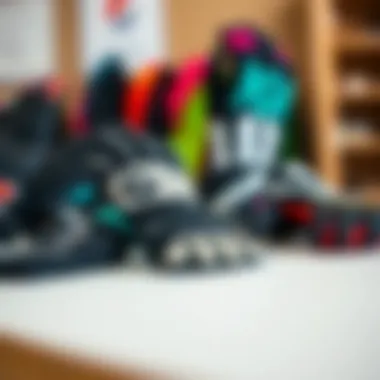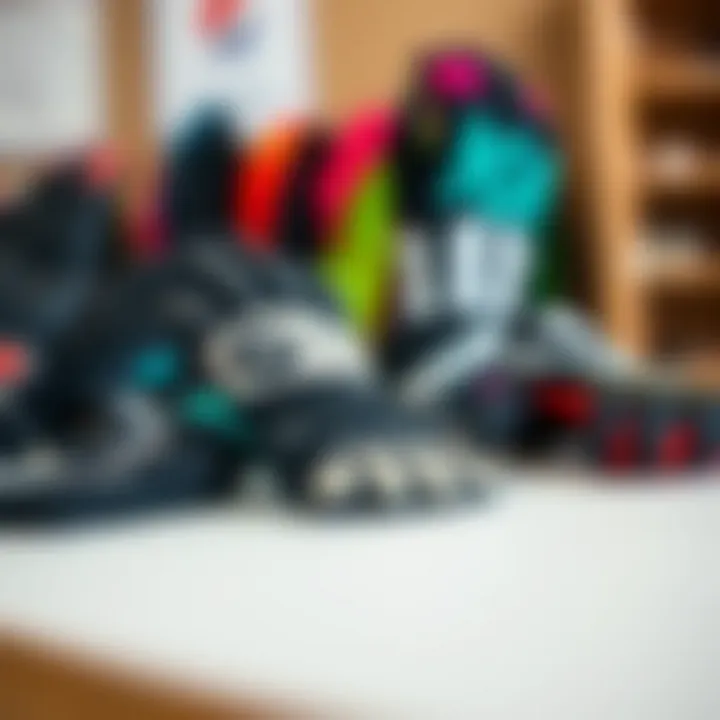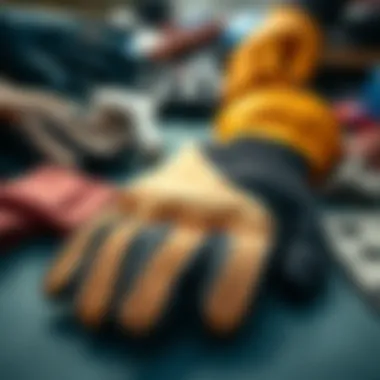Kitesurfing Gloves: Enhance Your Ride with Comfort


Intro
When it comes to kitesurfing, every bit of gear matters. But one piece that often gets overlooked are the gloves. These might just look like another accessory, but they actually play a crucial role in giving kiteboarders the edge they need. Not only do they protect your hands from harsh conditions, but they also enhance grip and improve your overall performance on the water.
Gloves specifically designed for kitesurfing come in various types and materials. Choosing the right pair can make all the difference between a smooth ride and a frustrating session. Whether you are a beginner learning the ropes or an advanced rider perfecting your tricks, understanding the features and benefits of kitesurfing gloves is essential. This guide aims to unravel the importance of these gloves so that both novices and veterans can make informed decisions about their gear.
Getting a handle on kitesurfing gloves doesn't just mean knowing what they look like; it involves understanding how the right fit, materials, and features can substantially enhance your experience on the water. A proper fit keeps your hands warm and agile, while specific materials offer protection against abrasion and water. As we dive deeper into this topic, we'll explore various factors to consider when selecting gloves and how to maintain them effectively.
From the right techniques that will keep you afloat to equipment reviews that highlight stellar gloves, this guide is your one-stop shop for everything you need to know. So let’s dive in and examine the intricacies of kitesurfing gloves.
Understanding Kitesurfing Gloves
Kitesurfing can be both exhilarating and demanding on the body, especially the hands. The primary goal of kitesurfing gloves is not merely about fashion on the waves; they serve essential functions that can elevate one’s performance and enjoyment in the sport. Understanding the role and significance of these gloves can help both newcomers and seasoned riders make well-informed choices.
The Role of Gloves in Kitesurfing
The gloves worn while kitesurfing are more than accessories. They play a significant role in providing comfort, protection, and grip. When you’re harnessing the power of the wind, your hands are doing the heavy lifting—controlling the kite, holding onto the board, and maneuvering through waves. Without the right gloves, one could be left with sore palms or even worse—abrasions or blisters that could sideline you for considerable time.
The materials used in kitesurfing gloves can vary widely; some are designed to withstand the harshness of saltwater and protect against UV rays, while others focus on flexibility. This balance is crucial: you want gloves that allow for dexterity but also offer robust protection from the elements. They essentially serve as a lifeline between you and your equipment, ensuring optimal control during rides.
Benefits of Using Kitesurfing Gloves
Utilizing kitesurfing gloves brings several notable benefits:
- Protection from Elements: Whether you’re battling chilly waters or harsh sunlight, gloves provide a barrier that can drastically improve your comfort level. They shield against cold winds and sunburn, allowing for longer sessions on the water.
- Enhanced Grip: Slippery conditions are not uncommon when kitesurfing. Gloves with textured grips prevent hands from slipping off the lines, giving you confidence to perform more intricate maneuvers.
- Reduced Fatigue: With a protective layer between your hands and the kite lines, the fatigue you experience after a session can be significantly lessened. This means more time kitesurfing and less time recovering from discomfort.
- Injury Prevention: A little extra padding can make a significant difference. The physical strain of holding the kite for extended periods can lead to strains and sprains. Gloves can help reduce the risk of these injuries.
Types of Kitesurfing Gloves
Understanding the various types of kitesurfing gloves is crucial for anyone involved in this exhilarating sport. The right gloves can make a difference not just in comfort but also in performance. When kitesurfing, your hands are your primary tools, operating everything from the control bar to quick adjustments of the lines. Choosing the appropriate type tailored to your conditions and skills can lead to a more enjoyable experience on the water.
Full-Finger Gloves
Full-finger gloves are a go-to option for many kitesurfers, especially those who venture into cooler waters. These gloves offer maximum coverage, ensuring your fingers stay warm while providing a more secure grip on the control bar. A snug fit can help avoid any excess flapping, which could potentially hinder your control.
Most full-finger gloves are made from materials that offer decent flexibility while maintaining a solid barrier against wind and splashes. However, the primary consideration should be the thickness of the material, as thicker gloves might sacrifice some dexterity. Look for gloves that balance warmth with mobility; no one wants to be fumbling with the lines because their fingers can’t flex!
Fingerless Gloves
Fingerless gloves are another popular choice, favored by kitesurfers who appreciate the freedom of movement in their fingertips. This type tends to be lighter and allows for greater tactile feedback when gripping your gear. If you find yourself kitesurfing in warmer climates, fingerless gloves can provide additional breathability while still offering some level of protection against chafing and potential sunburn.
These gloves typically feature reinforced palms and might include adjustable straps that help ensure a comfortable fit. However, it's essential to note that while they offer increased dexterity, they also leave the fingers exposed to the elements. Therefore, they might not be the best option for cold or rough conditions.
Neoprene Gloves
Neoprene gloves are a staple in the water sports community for a reason. Their material offers excellent insulation, which is why they're often chosen by those kiting in colder waters. Neoprene is also inherently stretchy, allowing for comfortable movement without compromising grip. Many gloves also feature sealed seams that further help retain warmth.
However, what stands out with neoprene gloves is their versatility. They come in various thicknesses, enabling you to select the perfect glove based on the temperature of the water. A thick pair might keep your hands warm in chilly winds, while a thinner option can be perfect for milder days. Just bear in mind, neoprene does require proper care to ensure longevity.
Lightweight vs. Insulated Options


When deciding between lightweight and insulated options, it's essential to consider the environment you'll be kitesurfing in. Lightweight gloves are often more versatile and can be beneficial for those milder summer days, where you might want to reduce bulk and enhance mobility. They can dry quickly and are typically easier to pack for travel.
On the other hand, insulated gloves are specifically designed for harsher, colder conditions. If your kitesurfing sessions see you battling chilly waters and biting winds, the extra insulation becomes not just a comfort, but a necessity. Investing in a quality insulated pair could mean the difference between enduring a session or needing to call it quits early due to cold.
In summary, the choice of kitesurfing gloves should be influenced by the conditions and personal preferences. Each type offers distinct advantages and disadvantages, serving different needs, whether you’re looking for warmth, dexterity, or a combination of both.
When exploring the vast waters of kitesurfing, having the right gear, especially gloves, can enhance your overall experience and keep you focused on mastering your craft.
Key Features to Consider
When choosing kitesurfing gloves, it's easy to gloss over the finer details. However, the right features can make a world of difference in your overall experience on the water. Understanding these elements not only helps in selecting the best gloves but also enhances comfort, performance, and safety during your kiteboarding sessions. Here are the critical features to consider:
Material Quality
The material of your kitesurfing gloves is paramount. Quality materials provide better durability, flexibility, and warmth, especially during chilly sessions. Common materials used include neoprene, synthetic blends, and even some natural fabrics. The choice comes down to a balance between comfort, performance, and resilience against the elements.
Take neoprene, for example. This rubbery choice is not only insulating but also allows for great range of motion. If you need gloves that withstand harsh beach environments, investing in high-quality neoprene can be a real lifesaver. Conversely, if you prefer something lighter, look for gloves with a mix of synthetic and breathable materials. Be mindful of seams too; strong stitching adds extra lifespan and prevents water from seeping in.
Grip and Control
A primary function of kitesurfing gloves is enhancing grip on your control bar and lines. Good grip is about more than just holding onto your equipment. It’s about maximizing your response to the wind and the water. A glove that offers poor grip can turn your thrilling ride into a slippery mess. Opt for gloves featuring textured palms or silicone prints to up your grip.
Moreover, some gloves have additional padding in strategic areas. This might seem redundant, but extra cushioning can promote control and comfort. Be conscious of how these features may influence your riding style; a glove that feels too bulky could hinder your ability to maneuver swiftly.
Sizing and Fit
Gloves that fit well are essential. A snug fit facilitates better control and sensitivity, allowing you to feel every little tug of your lines. Conversely, overly loose gloves can lead to blisters and poor handling, which no kiteboarder wants. When trying gloves on, remember that the perfect fit should allow some movement without being restrictive.
When assessing sizes, always check the brand’s sizing chart, as sizes can vary widely across manufacturers. Pay attention to finger length and width as well. A glove that’s too long doesn’t make for effective sailing. Try moving your fingers to ensure that you have the flexibility you need when gripping your gear.
Water Resistance and Drying Time
The nature of kitesurfing means constant exposure to water, thus making water resistance a non-negotiable feature for gloves. Quality gloves should effectively repel water while still being breathable. Nobody enjoys riding with soggy gloves—it hampers performance and can be downright uncomfortable.
Additionally, consider drying time after a session. Especially for those who frequently kitesurf, quick-drying gloves can save you from putting on cold, damp gear for the next go. Opt for materials known for their fast-drying properties.
By carefully considering these key features, you can select gloves that enhance your kiting adventures, helping you to catch the right wave and enjoy every thrilling moment.
Choosing the Right Kitesurfing Gloves
Selecting the proper kitesurfing gloves may not seem like a big deal, especially for newcomers who might think any pair of gloves will do. However, when you’re out there battling the wind and waves, the right gloves can make a world of difference. Not only do they enhance your grip on the control bar, but they also protect your hands from the elements. Getting this choice right can significantly boost your performance and enjoyment in the water.
When it comes to kitesurfing gloves, it's essential to align your choice with personal needs, preferences, and the specific conditions you'll face while riding. This section will detail how to assess your unique requirements and offer insights on comparing various brands and models available in the market.
Assessing Personal Needs
Before diving into brands or models, understanding what you specifically require from your kitesurfing gloves is critical. First off, consider the conditions you’ll be primarily kiting in. If you mostly ride in colder waters or during brisk weather, you might opt for insulated gloves that keep your fingers toasty. Conversely, if you’re more of a summer kiter, lightweight, fingerless gloves might just be your best bet, providing breathability and flexibility.
Next, think about your grip strength and how comfortable you are handling the control bar. Some riders prefer a snug fit to maximize tactile feedback, while others might want a bit of room for movement. Take into account your skill level too—beginners typically benefit from gloves that offer a firmer grip as they learn to control their kite.


Also think about any personal style; maybe you want gloves that reflect your aesthetic. Believe it or not, that can actually influence your confidence while out on the water.
"Personal comfort and functionality go hand in hand; pick gloves that you'll feel good in while you slice through the waves."
Comparing Brands and Models
Once you’ve nailed down your personal requirements, it’s time to sift through the brands and models available in the market. Lots of brands offer different styles, so it’s crucial to compare. Don’t just look at price; think about quality, material, and customer reviews. Some brands stand out due to their reputation for durability and performance.
A few noteworthy brands to explore include:
- Manera: Known for their innovative designs and durability.
- Dakine: Offers a range of gloves with great grip and comfort.
- O’Neill: Provides options that are popular for cold-water kiting.
- Mystic: Known for their stylish designs and functionality.
Take advantage of online forums and social media platforms like Reddit or Facebook groups dedicated to kitesurfing. Users often share valuable experiences and recommendations. A little research can save you time and money in the long run.
In the end, take your time when choosing the right gloves. Check out multiple models and try some on if you can. This isn’t just about picking an accessory; it’s about gear that can enhance your entire kitesurfing experience.
Maintenance and Care
When it comes to kitesurfing gloves, properly maintaining and caring for your gear is just as vital as selecting the right pair. Gloves endure a lot, from saltwater, sand, and constant exposure to the elements during intense sessions. Good maintenance can extend their lifespan, ensuring you get the most bang for your buck. Taking a little time to care for your gloves not only preserves their functionality but also enhances your overall kitesurfing experience.
Cleaning Techniques
Keeping your kitesurfing gloves clean is fundamental. Salt and sand can build up in the fabric and seams, making them less comfortable and potentially compromising performance. Here are some effective cleaning methods:
- Rinse After Use: Immediately after each kitesurfing session, rinse your gloves in fresh water. This simple act helps wash away salt and sand that could degrade the material over time.
- Gentle Hand Wash: If they’re particularly filthy, fill a basin with lukewarm water and add a small amount of mild soap. Soak the gloves for about ten minutes, gently scrubbing with your hands. Avoid using abrasive materials that might damage the glove’s surface.
- Air Dry: After cleaning, hang the gloves to air dry in a cool, shaded place. Don’t use heat sources like radiators or dryers, as these can warp the gloves or degrade the material.
Incorporating these routines into your care regimen helps keep your gloves in top condition, ready for your next adventure on the water.
Storage Tips
Proper storage is another important aspect of maintaining your kitesurfing gloves. How you store them can significantly affect their longevity. Here’s a rundown of tips to ensure your gloves remain in excellent shape:
- Avoid Folding: Store your gloves flat rather than folding them to prevent creases from forming that might compromise their fit.
- Use a Storage Bag: Consider keeping your gloves in a breathable mesh bag or a dedicated storage container. This protects them from dust, moisture, and direct sunlight which can degrade materials.
- Keep Away from Sharp Objects: Ensure that nothing sharp is in proximity when storing your gloves. This helps prevent any accidental tears or punctures that can happen easily.
By adhering to these cleaning techniques and storage tips, your kitesurfing gloves will not only serve you well during your adventures but will also retain their durability for many seasons to come.
"Taking care of your kitesurfing gloves is like looking after a good friend; it pays off when you need them most."
By investing the necessary time into maintenance and care, you can ensure that your experience on the water remains as enjoyable and hassle-free as it should be.
Top Brands in the Market
When it comes to kitesurfing gloves, the brand you choose can make a significant difference, not just in performance but also in comfort and durability. Selecting gloves from recognized brands helps ensure a level of quality and innovation that can enhance your kitesurfing experience. The market is teeming with various options, but not all gloves are created equal; some brands specialize in high-performance materials, while others may focus on affordability or specific features that cater to diverse needs.
In this section, we will delve into a brand comparison to help you make informed choices, and we will also review popular models from these top brands. This knowledge is essential, especially if you are a kiteboarder, instructor, or coach, as the right gear can substantially influence safety and enjoyment on the water.
Brand Comparison
- Dakine
Renowned for its durable construction and thoughtful designs, Dakine offers a variety of kitesurfing gloves ranging from lightweight to insulated options. Their products often feature reinforced seams and stylish aesthetics, making them a frequent choice among enthusiasts. - ION
ION stands out with its commitment to blending functionality and style. Their gloves often possess enhanced grip technology, crucial for maintaining control during intense rides. ION’s focus on eco-friendly materials is a significant draw for environmentally conscious riders. - Mystic
This brand is recognized for its cutting-edge designs and performance-oriented features. Mystic gloves are crafted with advanced materials that ensure both warmth and flexibility, catering to those who venture into colder waters. - Prolimit
Known for their budget-friendly yet high-quality options, Prolimit blends affordability with performance. Their gloves often feature a well-thought-out fit, providing comfort without breaking the bank, appealing to beginners and seasoned kitesurfers. - Globe
While traditionally known for surf gear, Globe also offers a range of kitesurfing gloves. They are praised for their innovative designs, often incorporating elements that aid in grip and dexterity, making them a suitable choice for trick riders.


Choosing a reputable brand ensures you are investing in quality materials that will withstand the rigors of kitesurfing. Yet, it's not just about the brand name; it's about how each option aligns with your riding style and environmental conditions.
Popular Models Reviewed
Here’s a look at some standout models from top brands that have garnered attention within the kitesurfing community:
- Dakine Vortex Gloves
These gloves are crafted with a neoprene exterior, offering excellent warmth and protection. They are equipped with a silicone grip on the palm, making them ideal for those demanding rides where control is paramount. - ION Neo Gloves
Known for their exceptional fit, these gloves boast a sleek profile that minimizes water entry while maximizing dexterity. The grip technology really shines when the wind picks up, ensuring that riders maintain a firm hold. - Mystic Star Gloves
These gloves feature a mix of neoprene and additional insulation for those chillier sessions. With a unique design, they provide not just comfort but also a warmth that allows for longer periods on the water without chilling your hands. - Prolimit Neoprene Gloves
A popular choice among budget-conscious riders, these gloves don’t skimp on performance or comfort. Their flexible nature gives a good level of movement which is essential for handling the kite. - Globe Rip Tide Gloves
A model designed with trick riders in mind, these gloves facilitate easy hand movements, allowing for effortless transitions. The grip under wet conditions is commendable, supporting dynamic movements crucial for advanced tricks.
Understanding the differences in brands and specific models will assist you in selecting the right gloves, ensuring optimal performance tailored to your kitesurfing style. Further information can be found at Dakine, ION, Mystic, Prolimit, and Globe.
By choosing wisely, you'll find gloves that not only keep your hands comfortable and warm but also enhance your overall kitesurfing experience.
Kitesurfing Gloves: Frequently Asked Questions
When it comes to kitesurfing, the right gear can make or break the experience. In this section, we will delve into some of the most common concerns and queries related to kitesurfing gloves. Understanding these frequently asked questions is crucial for both newcomers and seasoned riders, as they address common misconceptions, practical considerations, and safety tips related to glove selection.
How do know which size to choose?
Choosing the right size of kitesurfing gloves is paramount to both comfort and performance on the water. If your gloves are too tight, they may inhibit circulation, leading to numb fingers—definitely not ideal when you’re navigating the waves. Conversely, if they’re too loose, you risk compromising grip and control on your kite lines.
To find your perfect fit:
- Measure Your Hand: Use a tape measure to find the circumference of your dominant hand, just below the knuckles.
- Refer to Size Charts: Most brands have specific sizing charts. Compare your measurements with the guidance provided.
- Try Them On: If possible, try on different sizes. Look for snugness without discomfort, ensuring you can flex your fingers freely.
- Consider Layering: If you plan to wear thin liners under your gloves, take that into account when selecting your size.
In summary, the right size ensures your gloves work for you, not against you.
Are kitesurfing gloves necessary for beginners?
For beginners stepping onto the kiteboarding scene, the necessity of gloves can sometimes cause a bit of a debate. While it’s certainly possible to start kitesurfing without them, using gloves can enhance overall comfort and safety. Beginners may find that their hands can become sore from holding onto the lines consistently. Gloves provide a crucial layer of padding and can help prevent blisters, a common issue for those new to the sport.
Additionally, gloves can improve grip, which is vital when managing the kite. In challenging weather conditions or when the lines get wet, rubberized grips on gloves can significantly improve handling.
So, while beginners might initially forgo gloves, they could find that the comfort and protection they provide are well worth the investment.
Can use any gloves for kitesurfing?
It's tempting to think that any old pair of gloves can cut it for kitesurfing, but that’s not quite the case. Regular gloves—like those you'd wear in winter—often lack the specific attributes essential for kiteboarding. Whereas ordinary gloves might keep your hands warm, they typically don't offer the durability or grip required in water sports. Most importantly, they tend to absorb water, making them heavy and uncomfortable during sessions.
Instead, you should look for gloves designed specifically for kitesurfing. Such gloves are made with materials that withstand saltwater, provide excellent grip, and often have quick-drying capabilities. These gloves are also typically designed to allow full hand mobility while remaining tough against cuts or abrasions, giving you the confidence you need when out on the waves.
Ending
In the realm of kitesurfing, the significance of gloves cannot be overstated. These accessories serve not just as a safeguard against the elements but also play a crucial role in enhancing the overall kitesurfing experience. When it comes to navigating the waves, the right pair of gloves can mean the difference between a comfortable ride and battling against the biting chill or uncomfortable friction. The decision to invest in high-quality kitesurfing gloves can lead to substantial benefits.
Selecting gloves that meet personal needs while ensuring comfort and dexterity is paramount. This article emphasizes the various types of gloves available—from full-finger to fingerless options—each catering to different conditions and rider preferences. The material choice will drastically affect durability and comfort, and understanding this can help kitesurfers make informed decisions.
Moreover, as one dives deeper into gear selection, the importance of maintenance becomes apparent. Proper care extends the lifespan of gloves, ensuring that they remain reliable companions on every aquatic adventure.
Final Thoughts on Kitesurfing Gloves
As we wrap up this guide, it’s clear that kitesurfing gloves are more than just a luxury accessory—they are a necessity for anyone serious about enjoying their time on the water. Whether you are a seasoned pro or just started, investing thought into the gloves you choose can pay off in comfort and performance.
Remember to consider factors such as fit, material, and climate conditions.
👉 Always test gloves to ensure they fit snugly without being overly tight. A good fit helps maintain dexterity, which is essential when adjusting lines or controlling your board.















